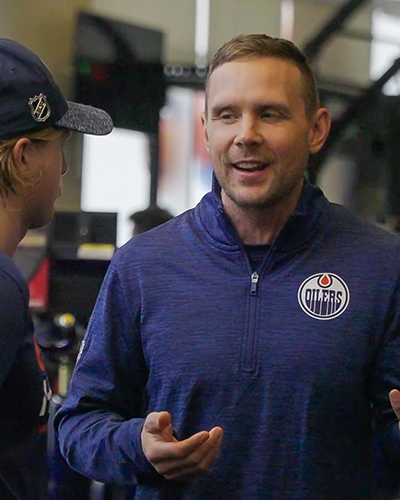How to train like an Oiler
Lewis Kelly - 11 October 2023

When Joel Jackson, ’11 BSc, '15 MSc, was growing up in Snow Lake, Man., he dreamed of a career in the NHL. In 2021, 10 years after graduating from the U of A’s Augustana Campus, he finally joined the Oilers — though not in the way he first imagined.
While Jackson doesn’t take the ice for the team, he plays a crucial role in preparing Connor McDavid and company for action. Jackson is a strength and conditioning coach with the Oilers, where he helps players get the most out of their bodies.
Here are four of his tips for working out.
Use the right data.
Jackson uses many high-tech exercise tools to help professional athletes get stronger, like a leg press machine that uses air resistance instead of metal plates. But his favourite tool doesn’t build muscle. It collects data.
“My favourite is called Catapult,” he says. “It allows you to quantify the volume and intensity of the work the players do on the ice through a number of different metrics.”
The tool is an inertial measurement unit, or IMU, that all Oilers players wear on their shoulder pads during practice. Over time, the IMU data builds a detailed portrait of a player’s skating ability. If a player gets injured, the data is a valuable tool for tracking when they are ready to return to play. For example, if the forces they produce while skating post-rehab are close to what they were doing before they got injured, it’s a strong sign they are ready to return to competition.
While an amateur athlete probably doesn’t need Catapult-level stats, they can still collect data about their workouts over time and mine them for insights. Smartphone running apps, GPS watches or even a paper workout log can help you track your training — both to establish a touchstone to use in the event of injury, or to chart your growing fitness over time.
Keep it fresh and fun.

One of the most powerful benefits of the cutting-edge tech Jackson uses in his job, he says, is also the most simple: novelty.
Like the rest of us, professional athletes can get bored of routine. Swapping out the squat cage for a 1080 Quantum smart pulley system can be a welcome break from the same old same old.
“It’s good for players to be exposed to these new tools,” he says. “It keeps it fresh and keeps them excited.”
The same idea can apply to a non-professional. But you don’t need expensive technology to introduce a little variety to your workout routine. Change up your running route, try out a new Peloton instructor or lift at a different gym.
Rank your priorities.
Jackson loves to play hockey. He played five years with the Vikings after playing Midget and Junior hockey in Manitoba, and still plays with friends today.
In his late teens he also developed a serious interest in strength training. While this set him on the path to his career today, he is not without regrets on the subject.
“I was highly regarded for my work ethic, which has served me well. I loved the gym and gravitated towards it,” he says. “But I wish I’d spent more time on the ice learning to handle the puck and less time trying to add another 100 pounds to my squat.”
Jackson says if your main athletic focus is to improve at a certain sport, most of your training time should involve that sport. Cross-training can be priceless (see the next tip for more), but make sure it’s a means to an end.
Don’t skip strength if you want to age gracefully.
While the strength and conditioning work Jackson does with the Oilers can boost the performance of players on the ice, its main benefit is for injury prevention and rehabilitation.
“Resistance training is still really undervalued in many different areas,” he says. But it’s important for long-term health.
This is true both for NHL-level athletes and the general population — especially as we get older.
“As people age, one of the biggest causes of injury is falls,” says Jackson. “The reason a fall can cause so much damage is that when you lose your muscular power, you can’t react to tripping or losing your footing. If you have more muscular power, there’s a much better chance that things like that won’t happen.
“Resistance training should be your number one injury prevention tool.”